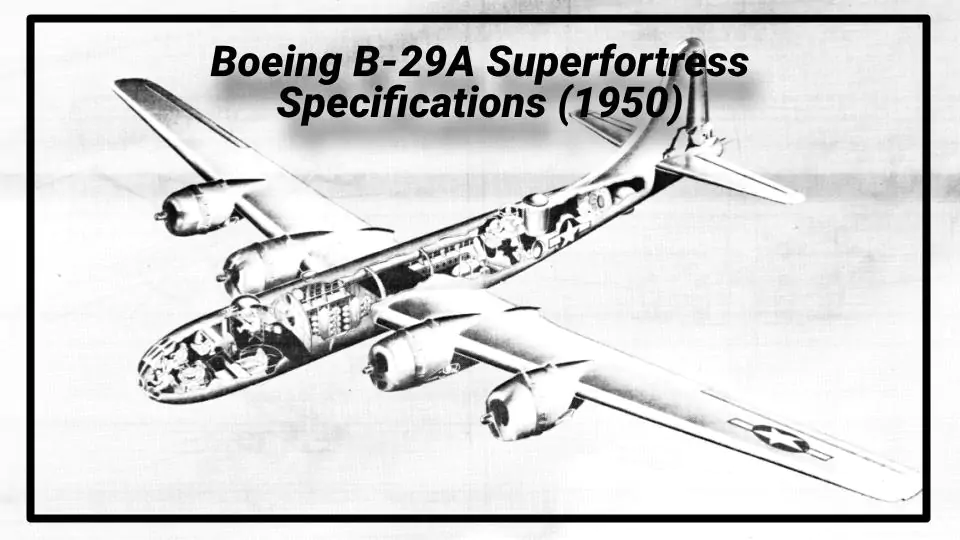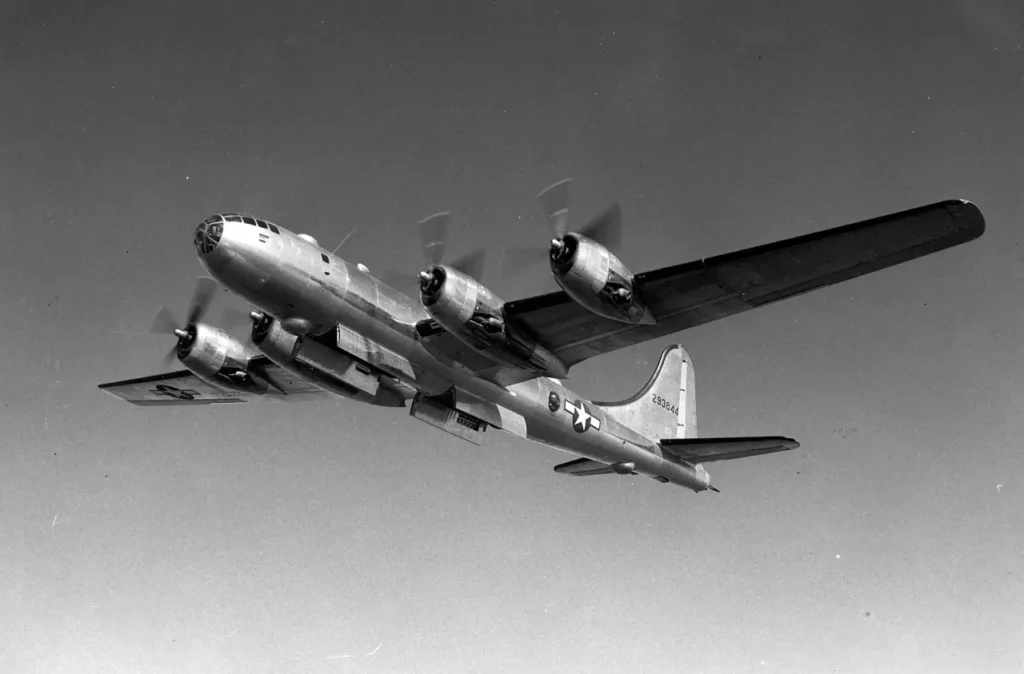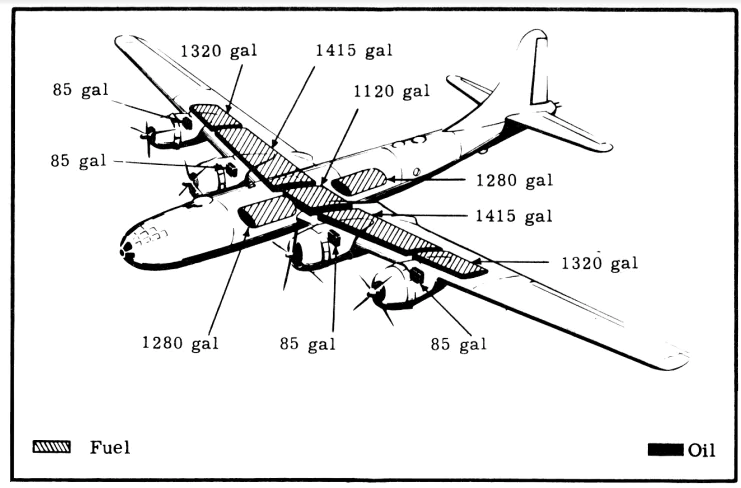
Mission
The main objective of the B-29A was the destruction of enemy equipment and facilities through aerial bombing.
Differences with B-29
While no external differences were visible between the B-29 and B-29A, a significant distinction existed in the wing installation. The B-29A featured a stub wing center section installed into the fuselage, while all other B-29s had two inboard wing panels joined at the aircraft’s centerline. This difference, which increased the B-29A’s wingspan by a foot, warranted a new aircraft designator.

Although the structural change simplified construction, it negatively impacted aircraft performance by increasing the empty weight by 706 pounds. Moreover, the usable fuel capacity in the center wing tank decreased by 213 gallons (from 1333 to 1120 gallons total capacity).
Development
The first B-29A saw acceptance in January 1944. Its production run lasted until June 1946. This aircraft was exclusively produced at the Boeing plant in Renton, Washington, which focused solely on manufacturing the B-29A version. Throughout its production period, the Renton plant successfully built 1,122 units of the B-29A variant.
Dimensions and Weights

| DIMENSIONS | US | Metric |
|---|---|---|
| Wing | ||
| 141.2 ft | 43 m | |
| 4° | 4° | |
| 4°29'23" | 4°29'23" | |
| 7°1'26" | 7°1'26" | |
| 1720 ft2 | 159.8 m2 | |
| 11.5 | 11.5 | |
| Boeing 117 | Boeing 117 | |
| 154.41 | 47.1 m | |
| Length | 99 ft | 30.2 m |
| Height | 27.8 ft | 8.5 m |
| Tread | 28.5 ft | 8.7 m |
| Prop. Grd Clearance | 1.3 ft | 0.4 m |
| WEIGHTS | ||
| Loading | ||
| 72,206 lbs | 32.752 kg | |
| 74,760 lbs | 33.911 kg | |
| Operating | ||
| 120,000 lbs | 54.431 kg | |
| 101,472 lbs | 46.027 kg | |
| 140,000 lbs | 63.503 kg | |
| 135,000 lbs | 61.235 kg |
(A) Actual
(*) For basic mission
(1) Limited by performance
(2) Limited by gear strength
Engines
| Attribute | Value |
|---|---|
| POWER PLANT | |
| (4) R-3350-57 or-57A | |
| Curtiss - Wright Corp., Wright Aeronautical Corp. Division | |
| 95-28266-5 | |
| (Dual Turbo) B-11 or B-31 | |
| 0.35 | |
| PROPELLER | |
| United Aircraft Corp., Hamilton Standard Propeller Division | |
| 6521A-6 | |
| Hydromatic | |
| 4 | |
| 16' 7" (5 m) | |
| ENGINE RATINGS | |
| 2200/2800rpm | |
| 2200/2600rpm/2500ft | |
| 2000/2400rpm/4000ft |
Electronics
| Equipment | US Designation |
|---|---|
| VHF Command | AN/ARC-3 |
| Interphone | AN/AIC-2A |
| Liaison | AN/ARC-8 |
| Radio Compass | AN/ARN-7 |
| Marker Beacon | RC-193A |
| Homing Adapter | AN/ARR-1 |
| Localizer | RC-103 |
| Glide Path | AN/ARN-5A |
| Radio Altimeter | SCR-718C |
| Interrogator | SCR-729 |
| Radar | AN/APQ-7 or AN/APQ-23A |
| Loran | AN/APN-9 or AN/APN-4 |
| IFF | SCR-695 |
| Raven | RCM |
Crew

The B-29A crew was made up of eleven members, comprising five officers and six enlisted personnel.
The crew was split into two pressurized sections: the forward compartment housed the bombardier, aircraft commander, pilot, flight engineer, navigator, and radio operator. Meanwhile, the rear compartment accommodated the central fire control gunner, left and right gunners, and the radar operator. The tail gunner operated from a distinct pressurized area beneath the rudder.
The list of crew members is the following:
- Pilot
- Co-pilot
- Navigator
- Flight engineer
- Bombardier
- Radio operator
- Radar operator
- Top gunner
- Left gunner
- Right gunner
- Tail gunner
Fuel system

As said at the top, the design change of the wing center section resulted in a loss of 213 gallons of fuel in the center wing tank.
| Location | No. Tanks | Gals | Liters |
|---|---|---|---|
| Wing, outbond* | 2 | 2640 | 9993 |
| Wing, inbound* | 2 | 2830 | 10713 |
| Wing, center* | 1 | 1120 | 4240 |
| Bomb bay | 2 | 2560 | 9691 |
| Total | 9150 | 34637 |
(*) Self Sealing tanks
Bombs and Guns
Defensive armament
The defensive setup of the B-29A featured five turrets governed by a centralized fire control system.
The weaponry comprised four remotely directed .50 caliber machine guns in the front dorsal turret, and two remotely directed .50 caliber machine guns each in the rear dorsal, front ventral, and rear ventral turrets.
Furthermore, the tail turret was equipped with two .50 caliber machine guns.
| No. | Calibre/ Rounds each | Location |
|---|---|---|
| 4 | .50 / 500 | Fuselage, upper forward |
| 2 | .50 / 500 | Fuselage, upper aft |
| 2 | .50 / 500 | Fuselage, lower forward |
| 2 | .50 / 500 | Fuselage, lower aft |
| 2 | .50 / 500 | Tail turret |
Bombs
When contrasted with the B-24 and B-17, the B-29A boasted a significantly greater maximum internal bomb load of 20,000 lb. This capacity was four times larger than that of the B-24 and five times greater than the B-17’s capacity.
| No. | Size | Type |
|---|---|---|
| 4 | 4000 lbs | General-purpose (G.P.) |
| 8 | 2000 lbs | General-purpose (G.P.) |
| 12 | 1600 lbs | Armor-piercing (A.P.) |
| 12 | 1000 lbs | General-purpose (G.P.) |
| 40 | 500 lbs | General-purpose (G.P.) |
Performance
The basic performance of the B-29A was the following:
Combat radius
1800 nm
with 10,000 lb of payload at 216 knots avg. in 16.90 hours
Combat range
3321 nm
with 10,000 lb of payload at 198 knots avg. in 16.88 hours
Combat speed
331 kn
at 25,000 ft alt, max power
Maximum speed
347 kn
at 30,000 ft alt, max power
Climb
500/1620
fpm sea level, take-off weight normal power
/fpm sea level, combat weight max power
Ceiling
23,950/
36,150 ft
100 fpm, take-off weight, normal power
/500 fpm, combat weight max power
Loading and Performance
Basic Mission, Max Bombs Mission, High Alt. Mission
| Conditions | Basic Mission | Max Bombs Mission | High Alt. Mission | |||
|---|---|---|---|---|---|---|
| TAKE-OFF WEIGHT | 140,000 lbs | 63.503 kg | 140,000 lbs | 63.503 kg | 140,000 lbs | 63.503 kg |
| 46,490 lbs | 21.088 kg | 38,690 lbs | 17.549 kg | 46,490 lbs | 21.088 kg | |
| 10,000 lbs | 4.536 kg | 20,000 lbs | 9.072 kg | 10,000 lbs | 4.536 kg | |
| 81.4 lb/sq ft | 397,4 kg/m2 | 81.4 lb/sq ft | 397,4 kg/m2 | 81.4 lb/sq ft | 397,4 kg/m2 | |
| 103 kn | 191 km/h | 103 kn | 191 km/h | 103 kn | 191 km/h | |
| 5,230 ft | 1.594 m | 5,230 ft | 1.594 m | 5,230 ft | 1.594 m | |
| 7,825 ft | 2.385 m | 7,825 ft | 2.385 m | 7,825 ft | 2.385 m | |
| 500 fpm | 152 m/min | 500 fpm | 152 m/min | 500 fpm | 152 m/min | |
| 23.5 min | 23.5 min | 23.5 min | ||||
| 61.5 min | 61.5 min | 61.5 min | ||||
| 23,950 ft | 7.300 m | 23,950 ft | 7.300 m | 23,950 ft | 7.300 m | |
| 19,400 ft | 5.913 m | 19,400 ft | 5.913 m | 19,400 ft | 5.913 m | |
| COMBAT RANGE | 3,321 n.mi | 6150 km | 2,583 n.mi | 4.784 km | 3,025 n.mi | 5.602 km |
| 199 kn | 369 km/h | 204 kn | 378 km/h | 223 kn | 413 km/h | |
| 10,000 ft | 3.048 m | 10,000 ft | 3.048 m | 20,000 ft | 6.096 m | |
| 16.88 hrs | 12.85 hrs | 13.71 hrs | ||||
| COMBAT RADIUS (5) | 1800 n.mi | 3.334 km | 1,428 n.mi | 2.645 km | 1563 n.mi | 2.895 km |
| 216 kn | 400 km/h | 215 kn | 398 km/h | 239 kn | 443 km/h | |
| 10,000 & 25,000 ft | 3.048 m & 7.620 m | 10,000 & 25,000 ft | 3.048 m & 7.620 m | 20,000 & 30,000 ft | 6.096 m & 9.144 m | |
| 16.90 hrs | 13.41 hrs | 13.33 hrs | ||||
| COMBAT WEIGHT (6) | 101,472 lbs | 46.027 kg | 96,900 lbs | 43.953 kg | 99,330 lbs | 45.055 kg |
| 25,000 ft | 7.620 m | 25,000 ft | 7.620 m | 30,000 ft | 9.144 m | |
| 331 kn | 613 km | 332 kn | 615 km | 347 kn | 643 km | |
| 1260 fpm | 384 m/min | 1,395 fpm | 425 m/min | 1,165 fpm | 355 m/min | |
| 36,150 ft | 11.019 m | 37,100 ft | 11.308 m | 36,550 ft | 11.140 m | |
| 39,550 ft | 12.055 m | 40,500 ft | 12.344 m | 40,000 ft | 12.192 m | |
| 34,550 ft | 10.531 m | 36,000 ft | 10.973 m | 35,300 ft | 10.759 m | |
| 1,620 fpm | 494 m/min | 1,745 fpm | 532 m/min | 1,675 fpm | 511 m/min | |
| 347 kn | 643 km | 348 kn | 644 km | 347 kn | 643 km | |
| LANDING WEIGHT | 84,236 lbs | 38.209 kg | 83,245 lbs | 37.759 kg | 84,236 lbs | 38.209 kg |
| 2,250 ft | 686 m | 2,225 ft | 678 m | 2,250 ft | 686 m | |
| 2,980 ft | 908 m | 2,950 ft | 899 m | 2,980 ft | 908 m | |
NOTES
(1) Take-off power
(2) Max power
(3) Normal power
(4) Take-off and landing distances are obtainable at sea level using normal techniques. For airport planning, distances should be increased by appropriate factors to determine runway requirements.
High-Speed Mission, Ferry Range
| Conditions | High Speed Mission | Ferry Range | ||
|---|---|---|---|---|
| TAKE-OFF WEIGHT | 140,000 lbs | 63.503 kg | 137,610 lbs | 62.419 kg |
| 46,490 lbs | 21.088 kg | 54,900 lbs | 24.902 kg | |
| 10,000 lbs | 4.536 kg | |||
| 81.4 lb/sq ft | 397,4 kg/m2 | 80.0 lb/sq ft | 390,6 kg/m2 | |
| 103 kn | 191 km/h | 102 kn | 189 km/h | |
| 5,230 ft | 1594 m | 4,980 ft | 1.518 m | |
| 7,825 ft | 2385 m | 7,410 ft | 2.259 m | |
| 500 fpm | 152 m/min | 530 fpm | 162 m/min | |
| 23.5 min | 21.8 min | |||
| 61.5 min | 56.5 min | |||
| 23,950 ft | 7.300 m | 25,500 ft | 7.772 m | |
| 19,400 ft | 5.913 m | 21,100 ft | 6.431 m | |
| COMBAT RANGE | 1,838 n.mi | 3.404 km | 4,393 n.mi | 8.136 km |
| 259 kn | 480 km/h | 191 kn | 354 km/h | |
| 10,000 ft | 3.048 m | 10,000 ft | 3.048 m | |
| 7.37 hrs | 23.10 hrs | |||
| COMBAT RADIUS (5) | 1,036 n.mi | 1.919 km | ||
| 275 kn | 509 km/h | |||
| 10,000 & 25,000 ft | 3.048 m & 7.620 m | |||
| 7.78 hrs | ||||
| COMBAT WEIGHT (6) | 103,806 lbs | 47.086 kg | 85,000 lbs | 38.555 kg |
| 25,000 ft | 7.620 m | 10,000 ft | 3.048 m | |
| 330 kn | 611 km | 293 kn | 543 km | |
| 1,195 fpm | 364 m/min | 2,025 fpm | 617 m/min | |
| 35,650 ft | 10.866 m | 39,700 ft | 12.101 m | |
| 39,050 ft | 11.902 m | 43,100 ft | 13.137 m | |
| 32,750 ft | 9.982 m | 39,050 ft | 11.902 m | |
| 1,555 fpm | 474 m/min | 2,140 fpm | 652 m/min | |
| 346 kn | 641 km | 353 kn | 654 km | |
| LANDING WEIGHT | 84,236 lbs | 38.209 kg | 85,000 lbs | 38.555 kg |
| 2,250 ft | 686 m | 2,260 ft | 689 m | |
| 2,980 ft | 908 m | 3,000 ft | 914 m | |
NOTES
(1) Take-off power
(2) Max power
(3) Normal power
(4) Take-off and landing distances are obtainable at sea level using normal techniques. For airport planning, distances should be increased by appropriate factors to determine runway requirements.
Further reading
- Boeing B-29 Superfortress Specifications (1950)
- Boeing B-29B Superfortress Specifications (1950)
- Boeing KB-29P Superfortress Specifications (1951)
- Boeing SB-29 Superfortress Specifications (1954)
- Tupolev Tu-4 Standard Specification & Performance
- Boeing B-29 Superfortress Facts: 11 things to know
Bibliography
- B-29 Superfortress in detail & scale, Part 1 by Alwyn T. Lloyd
- B-29A Superfortress Standard Aircraft Characteristics, 19-APR-1950, Air Materiel Command, U.S. Air Force